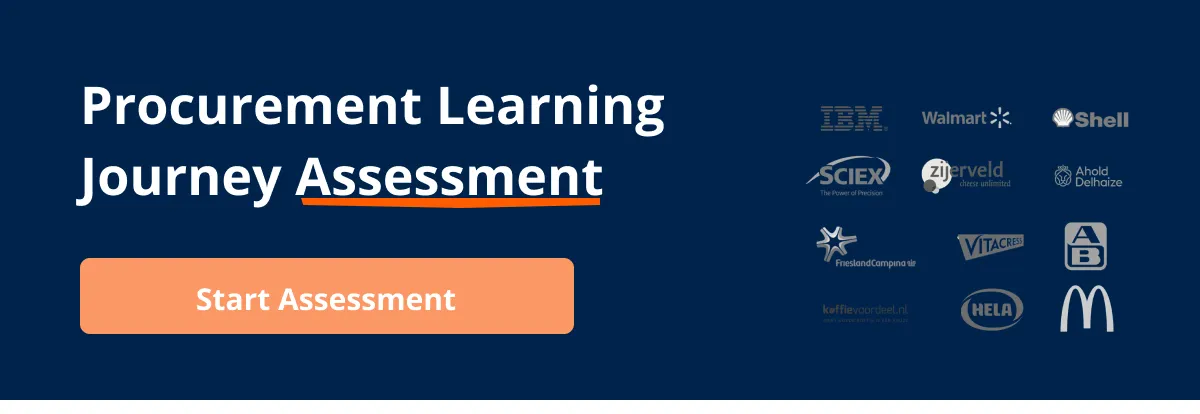Written by Marijn Overvest | Reviewed by Sjoerd Goedhart | Fact Checked by Ruud Emonds | Our editorial policy
Procurement Risk — Everything A Procurement Professional Should Know
Key takeaways
- Procurement risks are situations that disrupt your procurement processes leading to a failure.
- Failing to analyze your organization’s needs can land you in purchasing pitfalls and lead to insufficient or excess goods.
- Risk management is the method used by professionals to recognize the external and internal risks to your supply chain.
Procurement risk is the thing that all procurement professionals cannot avoid. We know that risk-taking is what makes our lives or businesses grow.
However, it is different from procurement risk. It is the last thing all procurement professionals want. Although procurement risks linger in every procurement activity, professionals can mitigate its effects that can severely harm the development of your business.
For this article, we will discuss procurement risk and how to lessen its effects on your procurement process. We will explore how important it is for procurement professionals to manage procurement risks in an organization.
After reading this article, you will know how to mitigate the risks in your procurement process effectively. Lessening the risks will allow you to streamline and fix any errors in your procurement process.
ProcurementRisks
We can describe procurement risks as opportunities for something to go wrong. Its occurrence and impact are typically uncertain in the procurement process of an organization.
Procurement risks include situations that has already happened, but did not have much time to react to the occurrence which is called delayed consequences.
To keep it simple, risks are anything that can impact the organization to achieve its goals and objectives negatively. These risks can manifest through quality issues, delayed deliveries, hiring employees, negative publicity, and unnecessary expenses.
Whatis Risk Management?
Every activity in the procurement process has its own risk attached to it. As we said earlier, risks cannot be avoided. However, you can mitigate it.
Risk management is the method used by professionals to recognize the external and internal risks to your supply chain.
This method allows you to eliminate situations that can put you at greater risk. Risk management creates solutions to lessen the impact of external and internal risks.
Effective risk management demands risk analysis. To keep it simple, you need to check for potential risks, their probability to happen, and whether you can avoid those risks without any interruption to the supply chain.
You should know that risk management is not a one-time event. You should do a regular assessment to ensure that you are prepared for any risks that may arise. Once it happens, you should be able to come up with a solution to mitigate its effects.
The Importance of Risk Management
Procurement nowadays is absolutely different from the procurement we had a few years ago. The development of procurement is gradually increasing and has become popular due to the pandemic.
The transformation of procurement requires strong risk management capabilities to ensure the success of every company in mitigating its risks.
Every movement in procurement involves decision-making. This activity affects every organization, especially if your decision does not consider different factors.
Conducting an efficient proper risk analysis can mitigate the effects of risks and minimize the disruption in your supply chain.
You can acquire the following benefits if you properly manage the risks across your procurement process:
- Responsible use of materials
- Better customer service
- Enhances supplier and client relationships
- Improves production
- Adapts innovation
The Most Common Riskin Procurement
Due to its intricacy, procurement is prone to a lot of risks. Here are the most common types of risks in procurement you should look out for:
1. Poor analysis of the organization’s needs
If you do not know the needed materials, when these materials are needed, and the time of delivery can put your supply chain in danger. If you had assessed poorly the needs of your organization, you might end up buying too much or an insufficient amount of goods.
Both the procurement strategy and financial plan will be severely affected if you do not check your spending analysis.
You need to check if the needs of the organization are stated accurately when sourcing materials or services. Also, this includes a realistic budget and delivery schedule when negotiating with your preferred suppliers.
2. Inefficient contract management
Many organizations have stories to tell when talking about inefficient contract management. Some contracts failed due to misunderstandings and contracts that have never had the chance to be executed. It is disappointing but it can be prevented.
Obviously, the contract should easily communicate its needs. However, it does not apply in reality because of poor contract management.
A contract is not just a document that has been born from your agreements. It is meant to develop your relationship with your supplier to lessen risks and reduce costs.
3. Poor supplier selection process
Selecting a supplier is one of the critical processes that dictate the success or failure of procurement in any organization.
Without reliable suppliers and strong supplier management systems, the procurement department spends more time fixing the problems instead of doing their responsibilities in the organization.
The risk of poor supplier selection includes low-quality of products, unreliability, delayed deliveries, compromised ethical standards, and non-compliance with your requirements.
4. Ineffective supplier relationship
Every one of us knows how important it is to have a robust supplier relationship. After all, they are the ones who provide for the needs of the organization.
No matter how hard-working you are, there will be gaps that will occur now and then. Miscommunication is a popular issue when it comes to supplier relationships.
When you fail to negotiate and build a relationship with your preferred supplier, then expect unfavorable contract terms and a lack of transparency.
5. Dependency on the manual process
The dependence of an organization on the manual process is inefficient. It is prone to errors and even fraud. Many businesses still rely on the manual process without noticing that they are wasting a lot of time and money on it.
Manual processes make it difficult to acquire transparency. It opens a lot of errors and the lack of real-time reports makes it easy to miss any indication of approaching risks.
Tips to MitigateProcurement Risks
After identifying common risks you need to watch out for, there are corresponding ways to mitigate them.
The following are examples of solutions to help you mitigate procurement risks:
1. Automate your procurement process
Times have changed so much that the modern procurement process requires the usage of modern tools.
A large business may use SAP procurement to streamline its process but it comes at a high price. Moreover, the effectiveness of the software greatly defeats its high price.
A procurement automation solution can solve the blockage in the procurement process for everyday businesses.
When you automate your process, the procedures become faster and errors due to manual processes are eliminated. This will allow your team to focus on their actual roles rather than wasting time fixing incorrect paperwork.
2. Employ a standard process in your procurement
Your team should know your plan for the indirect procurement process. This will allow them to know the protocols to follow in ensuring that all data is updated, accurate, and complete.
If everyone in your procurement team follows a standard process, then it will become easy to identify delays in the system.
3. Develop supplier relationship
You need to build a real and collaborative relationship with your supplier to iron out any discrepancies in your negotiation. Also, this will allow you to rely on them in critical times as they will do anything it takes to support and meet your demand.
Conclusion
Procurement risks are inevitable, but they can be prevented. As they are only opportunities for something in the procurement process to go wrong, they are unavoidable but you may be able to reduce their consequences.
The most common risks in procurement are poor analysis of the organization’s needs, inefficient contract management, poor supplier selection process, ineffective supplier relationship, and dependency on the manual process. However, there is more to these.
Further, it’s important that you can manage such risks regularly and consistently. Thus, once these risks arise, you can immediately mitigate their effects.
Frequentlyasked questions
What are procurement risks?
Procurement risks are situations or opportunities that can disrupt your procurement processes resulting in failure.
Can I avoid risks?
No business nor professionals can avoid being stricken by risks. However, you can mitigate it.
Is risk management important?
Yes. It is important to assess the risks that may cause disruption to your procurement process.
About the author
My name is Marijn Overvest, I’m the founder of Procurement Tactics. I have a deep passion for procurement, and I’ve upskilled over 200 procurement teams from all over the world. When I’m not working, I love running and cycling.


